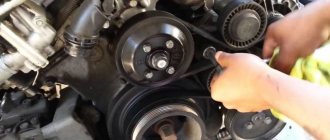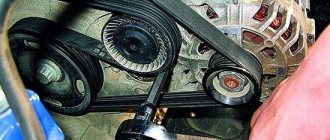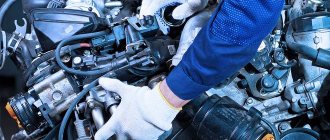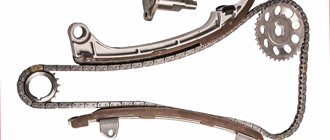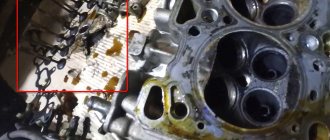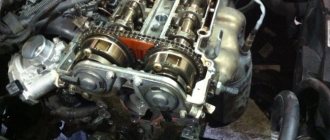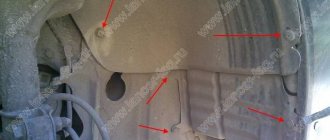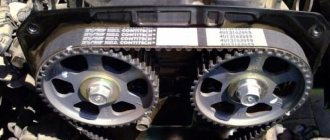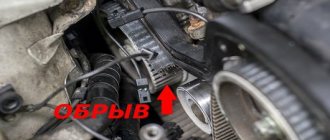Why does the timing belt whistle and how to fix it?
The timing belt itself cannot whistle, because the whistle is a consequence of slipping at high speed, which the timing belt is not physically capable of.
However, there may be several sources of such noise in the timing mechanism. First of all, the tension and deflection rollers (if present) will require attention: if their bearings jam, the belt pulled by the reverse side will squeal, quickly heating up and collapsing. With such a malfunction, you cannot continue driving under your own power, even if you know for sure that a broken timing belt on this engine will not lead to failure.
The video may cause another surprise. Unlike older V-belts or modern serpentine belts that drive alternators, air conditioning compressors and power steering pumps, the flat timing belt has no physical limit to prevent lateral movement. If the camshaft and crankshaft pulleys are on parallel axes with high precision, then a cheap aftermarket tensioner pulley can cause the belt to skew and slip to the side. As a result, the belt will gradually come off the pulleys and begin to rub against the cover. A characteristic noise and vibration of the lid will appear, which can be felt when touched.
It would seem that you can get to the service station - if the engine was working before, then it will last several kilometers. But it is impossible to guess the service life of a narrowed belt and the moment it breaks. A visit to the service cannot be postponed, and it is better not to get there on your own.
Choosing a new belt
Even if the culprit of the noise was not the belt, but a jammed roller, a normal technician will advise completely replacing the timing drive kit. Have you found yourself in this situation? Pay attention to two lines of Finwhale belts:
· CR – standard belts with an estimated service life of 100 thousand kilometers;
· HNBR – reinforced belts with an estimated service life of 150 thousand kilometers.
In any case, we recommend changing the belt at the frequency recommended by the manufacturer. The timing drive is not the place where savings are justified.
The secret to the durability and reliability of Finwhale belts lies in the details. Firstly, in a multilayer structure: a monolith would be stiffer and more prone to cracks, especially in our climate with temperature changes. Secondly, in the transition from rubber mixtures to more advanced ones. Finwhale uses highly saturated nitrile for HNBR belts. It retains mechanical properties over a wide temperature range and (especially important for used engines) is more resistant to contact with operating fluids - oil and antifreeze.
Finally, the tooth profile on the belt itself should closely match what the car manufacturer uses on the pulleys. With Finwhale you don't have to worry about this.
Source
Why is the timing belt noisy?
To find out the cause, you first need to inspect the entire belt drive.
- Make sure the belt is intact;
- Check the degree of tension;
- Make sure the shaft is clean;
- Check the line of two pulleys for misalignment
Keeping all parts of the car clean is a prerequisite for its smooth operation. Therefore, belt noise often occurs due to oil getting on this part, because the clutch is lost and it simply slips. The problem is solved by cleaning the belt from oils.
Insufficient tension is also the cause of whistling when the belt simply sags. When tightened, the noise is eliminated. If this is not done, the tape will easily fly off the pulleys. Insufficient belt tension is also a consequence of its tearing.
Deviation from the pulley line is another cause of noise. By checking the pulleys and aligning them in one line, the problem can be easily eliminated.
Too tight a tension also causes noise. Most often this happens in the winter, when a rubber band frozen in the cold cannot immediately gain elasticity and start working. But as soon as the engine warms up, the noise goes away. This phenomenon is not dangerous.
A worn bearing will also affect the sound of the belt. By replacing it, we will eliminate the cause of the whistle.
Increased electrical load on the car (headlights, radio, air conditioning and heated windows on) also causes noise.
If there is a need to replace the belt, it is better to do this with the help of specialists who will adjust its correct tension. Handicraft will negatively affect the performance of the car. It must also be changed after a certain mileage specified in the service requirements.
Why does the timing belt whistle after replacement?
1. The first reason is leakage.
It will be easier to figure out why the timing belt whistles after replacement if you find an oil, antifreeze or brake fluid leak. In any case, you will have to eliminate the leak, which is usually localized in the following places:
- When engine oil leaks, you should make sure that the cylinder head is completely sealed
. If it moves away from the block and oil penetrates from the resulting gap, you will have to remove the head and grind it. Then it is necessary to replace the gasket, since the main reason why the timing belt whistles due to oil leakage is the malfunction of this part.
- Have you discovered that coolant is leaking
? Look at the area where the cylinder head and the block itself are connected. Most likely, antifreeze is leaking into the engine due to a broken gasket. Make sure that the cooling system pipes are intact and nothing is leaking from them. - The reason why the timing belt whistles is a brake fluid or freon leak
? Then try to find where the leak is coming from. Start the engine and look at the timing mechanism. Most likely, you can fix the problem without removing the strap.
2. The second reason is weak tension.
Why does the timing belt whistle after replacement? This may happen because it is poorly tensioned. Therefore, first of all, make sure that the tension is sufficient. Then check to see if the whistling noise is coming from the alternator belt. To do this, press on it, if it bends with a force of 10 kg by 1–1.5 cm, then everything is in order. Then we proceed to check the timing belt. Normally, it rotates 90 degrees if you apply a force of 1-2 kg. In addition, you can purchase a tensioner that will allow you to set the correct value.
Functions of the timing belt
The internal combustion engine is equipped with a gas distribution mechanism. Its task is to fill the cylinders with the fuel mixture in a timely manner, as well as remove gases from them. To do this, the gas distribution mechanism opens and closes the intake and exhaust valves, which are on all engine cylinders, at the right time. The camshaft is also involved in the work; it regulates the operation of the valves. The gas distribution mechanism on all cars consists of the above elements.
The operation of the camshaft is possible if the crankshaft transmits torque to it. This requires a drive. It consists of pulleys located on the camshaft and crankshaft, and a belt with which the pulleys are connected. This is the timing belt.
That is, thanks to this part, the camshaft and crankshaft work synchronously. In addition, in some modern internal combustion engines, the timing belt forces the water pump to work.
Typically, internal combustion engine manufacturers place timing belts between the radiator and the cylinder block, in the front part of the engine compartment. On some car models, you will see the timing belt as soon as you lift the hood. But sometimes it is covered with a casing. One way or another, finding this part will be easy.
What does a timing belt look like? It is made in the form of a closed rim. There are teeth on its inner surface.
Note! There are no straps on sale that are suitable for any car. Different timing belts are available for different engines.
What could this part be made of? Previously, they were made from rubber with textile cord. Modern parts are made from ultra-strong fiberglass, as well as polymer compounds that are not afraid of temperature changes.
Of course, the timing chain is still stronger than the belt. But modern timing belts are wear-resistant, durable, and their service life is quite long. However, there are often cases when this part becomes unusable before the specified period or breaks.
In order for the car to always be on the move, it is necessary to monitor the condition of the main components. You can find out that a breakdown has occurred by the extraneous noise that occurs in certain situations. For example, you will immediately understand that the timing belt is whistling and the car is faulty.
We recommend
“The timing belt broke: who is to blame and what to do?” More details
Why does the belt of additional units whistle when starting the engine when cold: probable reasons
How to make sure
It’s not difficult to guess what to do when the alternator belt squeaks or what to do when it whistles - you need to check the tension. Often the belt structure is weakened due to unqualified assistance or stretching during long-term use. This is the first and simple rule when such a malfunction is detected. By the way, it is only available in the case of recent installation of a new product.
However, not all machines have units connected through a generator. On many cars with a timing chain drive, there may be two belts: one connects the current-generating unit and the cooling system pump to the engine. The second is a power steering pump and an air conditioning compressor with a motor.
The test method involves applying additional load to the belts by using the maximum power of the attachment. The alternator belt may squeal at idle if all electrical appliances are activated at the same time:
- Heated seats.
- Car radio.
- Heated side mirrors and rear window.
- High beam headlights.
- Cabin heater.
Diagnosis of the presence of extraneous sounds when another belt is operating consists of activating the air conditioning system while simultaneously rotating the steering wheel. The installation scheme of belt structures may be different - it all depends on the design features of the power unit.
For your information. Inspecting the engine compartment is the best method for determining the number of straps.
Causal factors
Insufficient tension is not the only reason why the belt whistles when starting the engine cold or hot. A worn-out product can also produce extraneous sound: the rubber component becomes tanned in the cold. Insufficient elasticity does not allow the transmission of torques of the required magnitude.
Contamination of the poly-wedge part leads to loss of proper adhesion properties due to rapid wear. It is critical to evaluate the presence of oil stains on the working surface of the strap. Often a whistle is observed a few seconds after passing a puddle. In this case, there is no need to take any action - the product will dry out and the squealing will go away.
So, where to start diagnosing if a whistle appears?
There can’t be two opinions here: the generator belt whistled, look for the reason in the generator itself. And in order to identify the source of the whistle, you must first find out the cause of this phenomenon. It could be:
- The belt is too worn
- The quality of the material does not meet GOST standards,
- The belt is heavily soiled or has oil stains.
But these may not be all the reasons why the alternator belt may whistle. In addition, it is advisable to check those parts that work together with the generator. This includes bearings and the mechanism responsible for belt tension,
To start diagnostics:
- Open the hood of the car.
- Find the alternator belt and visually inspect it.
- There should be no large cracks on the belt.
- It shouldn't look too worn out.
- Must have sufficient tension. Particular attention should be paid to this, since if the belt is loosely tensioned, this may be one of the main reasons why the belt whistles.
- Please ensure that all contacting parts are clean and dry and free of oil and other liquids.
If during a visual inspection you determine that the belt is very worn, then it is better to replace the belt. When buying a new belt, it is better to buy the original rather than chase a cheap Chinese fake. In this case, there is no point in saving, otherwise the whistling may happen again. If the accompanying parts (pulleys and flywheels) are dirty, this will not allow the belt to have normal tension. In this case, there is no need to change them - just wipe the dirty parts with a rag and clean them from dirt.
But sometimes it happens that during the first diagnosis it is not possible to determine why the alternator belt is whistling. But this does not mean that the reason is hidden elsewhere. It happens that a belt that has great rigidity will not be able to rotate well on the pulley. This happens when it's too cold outside and you're trying to start the engine.
In such cases, due to the low temperature conditions, the belt will become hard and this may slow down its rotation. In this case, the whistle may appear when you start the engine when it is cold, but it will gradually disappear as the engine warms up. Some cars have a special tension pulley. Therefore, during diagnosis, pay special attention to it. Primarily on wear of the bearings, which can also lead to an unpleasant sound. And often it is enough to replace this video and the sound will disappear.
Briefly about the causes and ways to eliminate them
If the belt begins to whistle when starting the car engine when cold, this is evidence that it is slipping. Inspection required. It is worth checking both the cleanliness and absence of cracks, and the tension level. A dirty, oily strap with a cracked working surface must be replaced. Dirt getting on the strap causes rapid wear not only of it, but also of the pulleys.
A clean product with a margin of service life is still suitable - just tighten it up if the system allows it. If this is not the case, then only installing a new one will help. The whistle appeared after a recent replacement - the belt was not tightened. Tightening does not help - either the pulleys are worn out, or the rubber product is not original. In special cases, a skewed tensioner is to blame for the squeak.
Source
What is the reason for the squeaking of the timing belt and how to fix it yourself?
The gas distribution mechanism is a rather complex device. In order for the mechanism to always operate in normal mode, it is necessary to diagnose it and replace the necessary elements from time to time. In this article you will learn why the timing belt whistles, what the reasons may be for this, and what to do if this problem occurs.
Belt whistles: diagnostics and search for causes
First of all, at the initial stage you should turn off the internal combustion engine, after which you should take a flashlight and very carefully inspect the generator belt for damage, delamination and other defects. It is important to note even the smallest cracks, protruding threads, etc.
- If defects are detected, the belt should definitely be changed. If visually it is in good condition, then the belt on the generator itself (provided that this element worked normally before) is not the cause of the whistle. We also note that during inspection you should pay attention to the presence of oil stains, moisture and accumulation of dirt on the belt.
Both the inside and outside of the belt must be dry and clean. The pulleys themselves must be clean. If no deviations from the norm are found, then you should proceed to checking the tension of the generator belt. In short, the belt should not sag or be too tight. If necessary, you need to adjust the belt tension.
We also recommend reading the article about which timing belt is best to choose. From this article you will learn about the features of selecting timing belts, what must be taken into account when choosing a timing belt, etc.
- If, after adjustment, the belt continues to whistle, the engine should be started and with the internal combustion engine running, carefully inspect the line of the pulleys, as the alignment may be disrupted. For example, if a serpentine belt is jumping or slipping off a pulley, this often indicates problems with pulley alignment.
It is also important to observe how the pulleys rotate. If one of the pulleys produces a figure of eight during linear rotation, then there is a high probability of the belt jumping. By the way, if the pulley has a rubber damper, then the said rubber ages over time, loses its elasticity and the damper does not work properly.
- Let’s also consider the case when visually everything is normal, and the belt itself is normally tensioned, but squeaks. It happens that even if there is no visible dirt, the belt needs special cleaning. To do this, you need to remove it, then treat the surface from the inside and outside with gasoline or kerosene.
If no damage is detected, it is necessary to thoroughly wipe the belt from dirt and dust. This can be done with a brush with soft or medium-hard bristles. At the same time, the pulleys are also cleaned, after which the belt is put back on and tightened.
- There are also special rubber conditioners on sale that are applied directly to the belt to extend its service life, maintain elasticity, etc. It happens that after treatment with such compounds, the belt stops whistling and squeaking on a permanent basis or temporarily.
Separately, we would like to add that if the replacement was recently carried out and the belt is new, it is possible that the size of the alternator belt was selected incorrectly. It is not uncommon in the spare parts market when the alternator belt dimensions in the catalog are suitable for cheap analogues, but physically they are not entirely accurate. Also, one should not exclude the possibility of an error when a belt that is visually suitable in length is not entirely suitable for the car.
In turn, if the methods listed above do not help in any way, then the problem is not related to the belt and the cause needs to be looked for further, and already in the attachment.
You need to check everything, from the tension rollers and bearings of the generator to the power steering pump, water pump, air conditioning compressor and other equipment. In some cases, the cause is grease or wear in the bearings, while in others the power steering pump, etc. may be problematic.
Understanding the device
To understand why the timing belt whistles after replacing it or after a long period of use, when starting the engine or simply when it is running, you need to understand the device. The issue of noise is pressing for many domestic motorists.
Removing the timing belt
The timing belt is a device that ensures the admission of the combustible mixture into the engine cylinders and the further removal of exhaust gases from the combustion chamber. This mechanism, as mentioned above, is one of the most complex motor devices, since it must not only open and close the valves. The timing belt must be done in a specially designated period of time. In any case, the operation of the unit must be synchronized with the functioning of the ignition and injection system.
When the driver needs to increase the speed, he presses the gas pedal, thus ensuring that more gasoline and fuel mixture enters the engine. This device consists of several groups of parts. Engine valves are designed to open and close intake and exhaust ports. The engine drives ensure rotation of the shafts at a specific speed. And the purpose of the distribution pulleys is to control the valves.
A head is installed above the cylinder block of the internal combustion engine, on which you can see the distribution pulley, valves and pusher devices. The timing pulley disk is located outside the cylinder head. To prevent engine fluid from leaking out from under the valve cover, a special oil seal is installed on the camshaft. The timing belt, which suddenly whistles after replacement, is put on the camshaft pulley disk and begins to function when the crank pulley gears rotate.
To ensure that the timing belt is always well tensioned, tension rollers are used. The strap itself ensures the operation of the device, and the drive strap ensures the operation of additional equipment. This is what the gas distribution mechanism system looks like in brief. But why did the noise appear when the engine was cold when starting? And why does the timing belt whistle after replacement? How can this noise be related to the operation of the engine?
Possible causes of belt noise and howling
In fact, such a problem, when drivers do not know why the noise appears when the engine is cold when starting the engine or after replacing the timing belt, is common. Next, we will try to answer why the belt whistles and what it might be connected with. So, why does the timing belt whistle after replacement and why does the noise occur when the engine is started cold? There are several reasons for this:
- The first and most common reason is element wear. The whistling of the timing belt is typical for those elements in which the teeth have already worn out and which slip when the pulleys rotate. In this case, it is quite possible that it will quickly fail, that is, the strap will break. If you want to avoid the problem of the element breaking in the future, then it is advisable to replace it with a new one. Sometimes in this case, additional tension of the component can help, but, as a rule, it only eliminates the whistling problem, but if the element is already worn out, then nothing will help it except replacement.
- The belt also often whistles after replacement if liquids get on it. If the noise appears when the engine is cold when starting or after replacement, then this may indicate to the motorist that there is a leak in the engine or coolant. In principle, it can be any liquid, not just oil or antifreeze. Perhaps the brake fluid also got on the element for some reason. In addition, consumables may end up on the disk of one of the pulleys. It is necessary to eliminate the cause of the leak, and then also replace the component.
- If noise appears immediately after replacement, this may indicate that the quality of the element is too low. Perhaps you purchased it for little money and the strap is of low quality. Nothing will help here except how to change the element. Of course, it can work for a certain time and not whistle if it is lubricated. But in this case, it should be periodically diagnosed in order to prevent its breakage in time.
- Also, one of the common reasons why noise appears after replacement is wear on the tension rollers. Perhaps they have simply reached the end of their service life and it’s time to replace them. Most likely, nothing will help in this case other than replacing the part.
What can cause a whistling alternator belt?
Every driver who has at least 2-3 years of driving experience can determine the malfunction of his car not only by sight (when something has already fallen off) but also by hearing, when suddenly, quite unexpectedly, the car begins to make strange and frightening sounds. The most common such phenomenon will be the sound when the alternator belt whistles. And such “whistling music” cannot be confused with anything.
But if you catch such a sound, then rest assured that it will haunt you whenever you start the engine when it’s cold. Until you fix this problem. Sometimes car enthusiasts believe that eliminating this sound is quite simple. You just need to replace the old belt with a new one and the cause of the whistle will be eliminated. But this can only be partially said. It’s better, of course, to figure out why the alternator belt is whistling. This article will help you with this.
Step-by-step instructions for eliminating the defect
If noise appears when starting the engine after replacing an element, then there are several ways to eliminate the problem. Each of them will be considered in turn. If the quality of the strap is too low and it is already worn out, then it will need to be replaced; there are no other options. We will not consider this process, since it is individual for each car.
Use the search on our website to find step-by-step instructions for replacing an element for your car. You will find more information about this here. Next, we will look at options for eliminating the problem without removing the strap.
Lubricating the strap
Lubricating the element is one of the solutions to the problem if, after replacing the component, noise appears when starting the engine.
To lubricate the component, you need to purchase a special aerosol, which is sold in any store. In addition, universal WD-40 can be used for these purposes. Naturally, this solution is temporary, but it will only take a few minutes, after which the noise will no longer bother you.
Lubricated tension roller
- Take your aerosol and open the hood of your car.
- Remove the protective cover of the mechanism, which is secured with bolts, using the appropriate wrench.
- Be careful as you will need to start the car for it to work. This will make lubrication more effective. After starting the engine, you will need to aim to ensure that the liquid hits the inner parts of the strap, that is, the teeth. Lubricate the element for five to ten seconds so that the liquid is guaranteed to reach all the teeth.
- Stop the engine and replace the mechanism cover. Enjoy the results.
Repairing the leak
If the reason why the whistle appears is the ingress of engine oil or other liquid, then it is necessary to eliminate all possible leaks:
- If engine oil gets in, first check the cylinder head for leaks. If the head even slightly moves away from the block itself and oil comes out, then you will need to dismantle the head and grind it. You will also need to change the gasket, since in practice it is the cause of oil leakage.
- If antifreeze is leaking, then also check the contact point between the cylinder head and the block itself. It is possible that coolant enters the engine due to a broken gasket. Also check all cooling system pipes to ensure they are not leaking or leaking.
- If the problem is “brake fluid” or, for example, air conditioning fluid, then you need to identify all possible leaks. Observe the timing mechanism with the engine running. You may be able to identify the problem without removing the belt.
